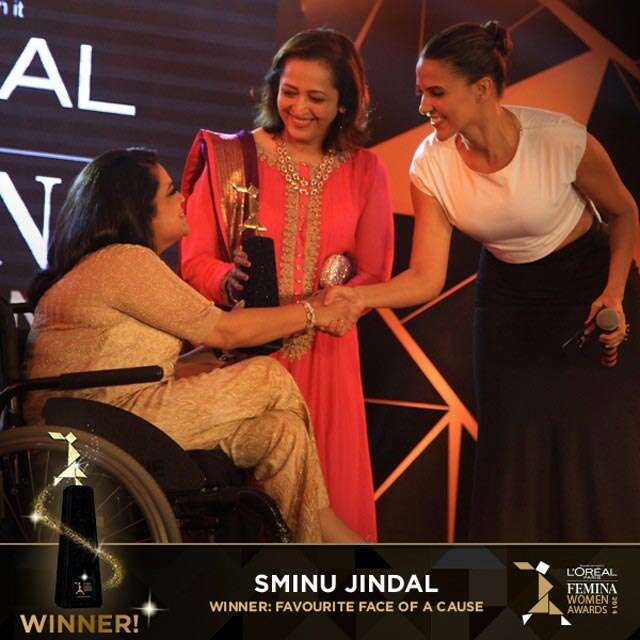Rooting for equal opportunities
by Smrity Sharma |Femina India | March 20, 2015,
Businesswoman Sminu Jindal was the winner of L’Oreal Paris Femina Women Awards 2014 in the Favourite Face of a Cause category. One year since the awards, the unstoppable Sminu, who was recently conferred with the Global Youth ICON Award for her commendable work in promoting the rights and dignity of the elderly and persons with disabilities, talks to us about the developments at her NGO Svayam, the challenges so far and upcoming projects in the coming year.

Tell us about the new developments at Svayam since the awards in 2014?
We have been working towards providing equitable access to public infrastructure and opportunities to all including the elderly and persons with disabilities. In absence of an accessible and enabling job portal, thousands of job aspirants are left behind and rarely get an opportunity to be contributing partners in nation’s economic growth process. Persons with disabilities have the right to work on an equal basis with others. However, they are often not considered potential members of the workforce due to lack of awareness about their abilities and prevailing myths and prejudices.
In order to create equal opportunities and shouldering equal responsibilities, Svayam in association with ASSOCHAM launched a Job Portal www.equalopportunities.in which is a step towards mainstreaming this marginalized segment into the society and enabling them to lead a life of economic independence and dignity.
Svayam also conducted the access audit of Mumbai Monorail to highlight the accessibility features and best practices in providing inclusive infrastructure for livable communities. To make the Legal System accessible to elderly and disabled, Delhi Police has sought expert opinion from Svayam to undertake access audits of all police stations, office buildings etc. across Delhi. In this exercise, a total of 181 police stations, 11 district DCP’s offices in Delhi are to be audited.
New challenges, changes and initiatives for the cause in 2014 and upcoming in 2015.
Our initiatives in the public domain are dependent on governmental support for success. Recent government policies are heartening. Finance Minister Arun Jaitley’s declaration of a new scheme to provide physical aids for senior citizen living below poverty line, and the scheme to provide assistance to disabled persons for purchase and fitting of aids and appliances, affirm the government’s commitment to addressing challenges faced by those with limiting physical conditions, and helping them be productive members of society.
We also welcomed the announcement to develop World Heritage Sites – including the Jallianwala Bagh premises where we’ve been evaluating ease of access for disabled visitors – to make them more tourists friendly. We hope the government will be open to partnering with us to carry out accessibility audits to realize this goal. At railway stations battery-operated cars to ferry the old and differently-abled is a great move. But a safe corridor to manage passenger traffic to ply these battery operated cars for elderly, and disabled, between platforms needs to be developed.
The government allocated Rs.110 crore for Department of Disability Affairs last year. We look for further investments in the programs like skill development, making public infrastructure accessible to all and creating accessible infrastructure. At stations, we expect to have a universal design / coaches with furnished accessible washrooms, entry and exit gates, considering the needs for differently-abled people. Braille stickers with layout of coaches including toilets, provision of wheel chairs and battery operated vehicles at more stations should be available and coaches should be made more wheel-chair friendly. Going forward, technology will play a big role in making public spaces more accessible for all regardless of age or physical abilities. It should be considered as an important element in new infrastructure.
Your wish and hope for the year 2015?
In the words of President Obama, “People with disabilities deserve the chance to build a life for themselves in the communities they choose to live in.” This is a cause I believe in very strongly. I also believe that to usher in change at the level of thought, we need to educate and empower our students as they are truly the future of our nation.
My intention and every effort have been to help change mindsets, especially among the students and make them aware of the need for an inclusive and accessible environment.
As the MD of Jindal SAW and founder of Svayam, interaction with people is a critical aspect of my day. It helps me understand and assess the ground realities. I am a mother, a businesswoman, an activist and an artist. I truly believe well rounded development of the mind and body is critical for all especially students. I would like to do is to implement this philosophy by promoting interactions for children with accomplished individuals from varied fields.
As a mother of two young boys, I believe it is vital that we expose our children to the values of gender sensitization and equality. That is another area I would like to focus on.
Source: Femina India Website


